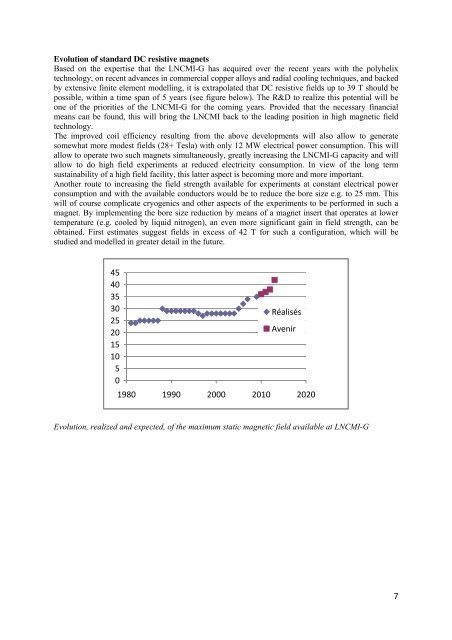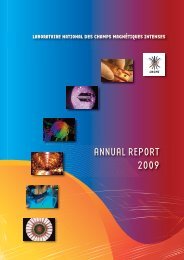Laboratoire National des Champs Magnétiques Pulsés CNRS – INSA
Laboratoire National des Champs Magnétiques Pulsés CNRS – INSA
Laboratoire National des Champs Magnétiques Pulsés CNRS – INSA
Create successful ePaper yourself
Turn your PDF publications into a flip-book with our unique Google optimized e-Paper software.
Evolution of standard DC resistive magnets<br />
Based on the expertise that the LNCMI-G has acquired over the recent years with the polyhelix<br />
technology, on recent advances in commercial copper alloys and radial cooling techniques, and backed<br />
by extensive finite element modelling, it is extrapolated that DC resistive fields up to 39 T should be<br />
possible, within a time span of 5 years (see figure below). The R&D to realize this potential will be<br />
one of the priorities of the LNCMI-G for the coming years. Provided that the necessary financial<br />
means can be found, this will bring the LNCMI back to the leading position in high magnetic field<br />
technology.<br />
The improved coil efficiency resulting from the above developments will also allow to generate<br />
somewhat more mo<strong>des</strong>t fields (28+ Tesla) with only 12 MW electrical power consumption. This will<br />
allow to operate two such magnets simultaneously, greatly increasing the LNCMI-G capacity and will<br />
allow to do high field experiments at reduced electricity consumption. In view of the long term<br />
sustainability of a high field facility, this latter aspect is becoming more and more important.<br />
Another route to increasing the field strength available for experiments at constant electrical power<br />
consumption and with the available conductors would be to reduce the bore size e.g. to 25 mm. This<br />
will of course complicate cryogenics and other aspects of the experiments to be performed in such a<br />
magnet. By implementing the bore size reduction by means of a magnet insert that operates at lower<br />
temperature (e.g. cooled by liquid nitrogen), an even more significant gain in field strength, can be<br />
obtained. First estimates suggest fields in excess of 42 T for such a configuration, which will be<br />
studied and modelled in greater detail in the future.<br />
45<br />
40<br />
35<br />
30<br />
25<br />
20<br />
15<br />
10<br />
5<br />
0<br />
Réalisés<br />
Avenir<br />
1980 1990 2000 2010 2020<br />
Evolution, realized and expected, of the maximum static magnetic field available at LNCMI-G<br />
7







